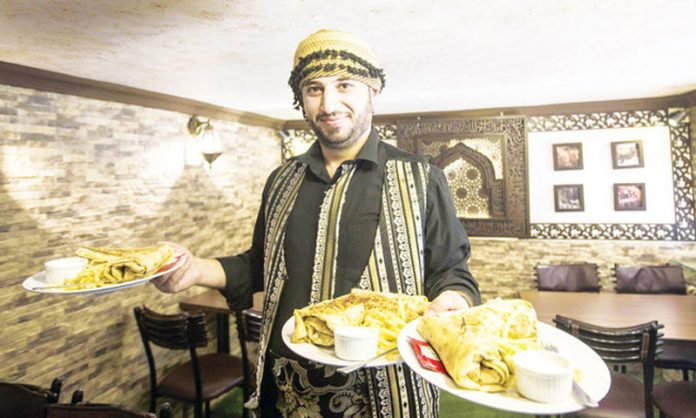NUSEIRAT REFUGEE CAMP, Palestinian Territories: Anas Qaterji fled war-torn Syria after his family restaurant in Aleppo was crushed by bombs in 2013.
First he made his way to Turkey and then Egypt, before slipping into the Israeli-blockaded Gaza Strip through a tunnel under the border.
Since his arrival in 2013, he has attempted to recreate life in the formerly prosperous Syrian economic capital by opening a restaurant identical to the one he left behind near the citadel of Aleppo.
In Nuseirat Palestinian refugee camp, south of Gaza City, 29-year-old Qaterji was able to buy a 50-square-meter facility for $50,000.
From Aleppo, he managed to salvage a 500-year-old wooden panel inscribed with Qur’anic verses, which now stands in the middle of the small restaurant in the huge Nuseirat camp, where nearly 160,000 refugees live in overcrowded conditions.
Above traditional coffee pots and antique copper cups, a sign reads: “Restaurant Jar Al-Qalaa 2: Taking you to Aleppo.”
“Here, everyone speaks about Aleppo. The Palestinians follow the Syrian news closely,” says Qaterji.

It is difficult to put an exact number on the Syrians in Gaza, most of whom entered from Egypt during the short presidency of Muhammad Mursi, ousted in 2013, via illegal tunnels that Egypt has since largely destroyed.
But according to several sources, between 150 and a few hundred of them reside in the small territory held firmly by Hamas and ravaged by three wars since 2008 and endemic unemployment. None of them have formally declared their entry or are officially registered.
Warif Qassem Hamido, head of an association of Syrian families in Gaza, also left everything behind in Aleppo. He arrived in Gaza one day in 2013, along with eleven other Syrian families.
He opened his “Syriana” restaurant but very few Syrians have managed to rebound and start businesses.
For all other war refugees, life in the crowded Palestinian territory is “very hard,” Hamido said.
In the small enclave where the unemployment rate is 45 percent and inflation continues to climb, the Syrians “have no way to pay their rent, to care for themselves or pay their children’s university expenses,” he added.

More than three quarters of Gaza’s population are registered as refugees with the UN.
For emergencies, Hamido’s group — which has a television program on the Syrians of Gaza — launches Facebook appeals.
Qaterji, meanwhile, pines for his aging parents who stayed in Aleppo, but he will not return to them as he has found a wife in Gaza.
At Qaterji’s restaurant, customers enter one after the other to buy shawarma (meat sandwiches) and other Syrian favorites at affordable prices.
Among them is Nadia Baraka, for whom a visit is a visual and gastronomic treat as well as a gesture of support.
“I’m showing my solidarity with the people of Aleppo, who are undergoing the same suffering as we have endured during the Israeli offensives,” said the 20-year-old student, gazing at the elegant decor of the room, where staff in Ottoman dress serve diners.
That kind of support is not enough for Majed Al-Atar, 47, who arrived from Damascus in the summer of 2012 through a tunnel.
He left the Syrian conflict only to live through two Israeli offensives on Gaza. Unable to find permanent work, he cannot pay for his children’s school or the eye operation his wife needs.
Forced to rely on charitable associations and with no help from the authorities, he said, “the authorities in charge of the refugees must get us out of Gaza and relocate us elsewhere, because the situation is getting worse day by day.”





